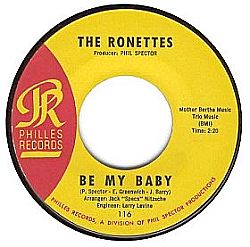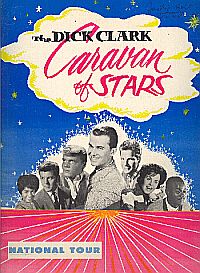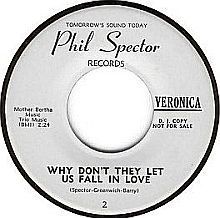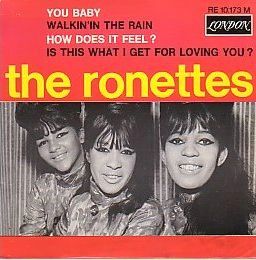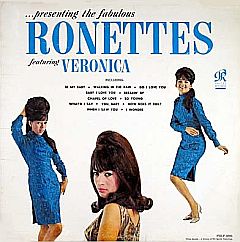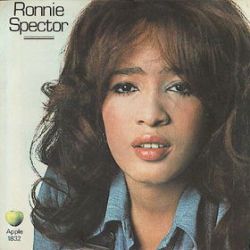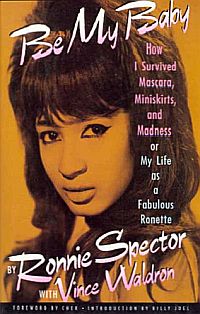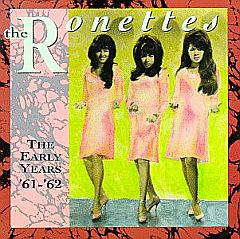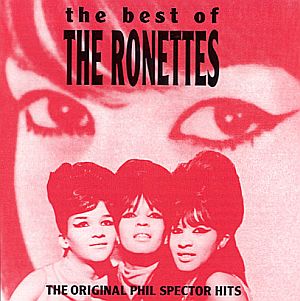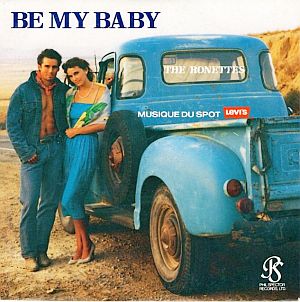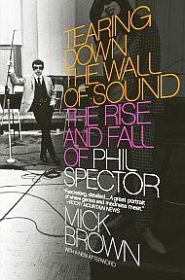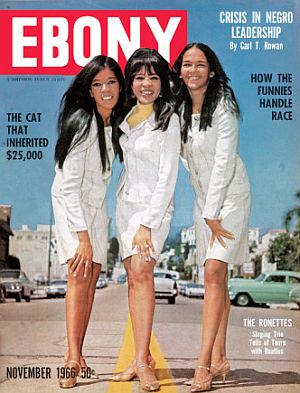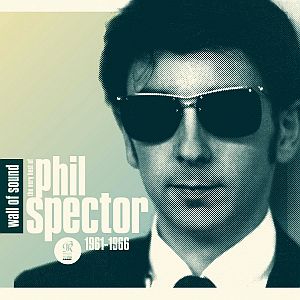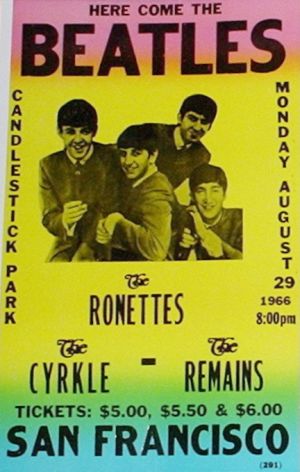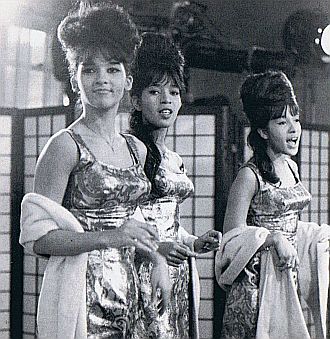
The Ronettes at the top of their game, circa 1964-65, from left: Nedra Talley and sisters, Estelle & Ronnie Bennett.
In 2006, the U.S. Library of Congress chose the Ronettes’ “Be My Baby” to be added to the National Recording Registry. The song is also ranked at No. 22 on Rolling Stone’s list of “The 500 Greatest Songs of All Time” published in 2004.
Brian Wilson of the Beach Boys — no slouch when it came to composing ground-breaking 1960s’ music of his own — has called “Be My Baby” one of the greatest pop records ever made and is his “all-time favorite song.” Wilson was in his car when he first heard the tune on the radio, and being the composer and arranger that he was, stopped the car to give the song a closer listen. “I had to pull off the road,” he said. “I couldn’t believe it. The choruses blew me away…” Wilson, in fact, so taken with the song’s instrumentation and arrangement, played it hundreds of times to “deconstruct” its elements so he might become a better studio producer himself. It is also said that he wrote a famous Beach Boys song, “Don’t Worry Baby,” initially as a follow-up intended for the Ronettes, but it was turned down for that purpose.
“Be My Baby,” in any case, was a musical production tour de force circa 1963, and it became part of a game-changing new sound then sweeping through pop music. The song, in addition to the Ronettes’ vocals, had some storied talent in its making. It was co-written by one of those well-regarded 1960s’ writing teams who worked at New York city’s famed Brill Building music center — Ellie Greenwich and Jeff Barry. Another co-author of the song was studio wunderkind Phil Spector, who most notably produced the song’s lush instrumentation. Spector had also signed the Ronettes to his Philles record label earlier that year. More on Spector in a moment.
Released as a single in August 1963, the song gradually rose on the U.S. music charts, hitting No.2 on the Billboard pop chart by October, and also No. 4 on the U.S. R & B chart, and No. 4 in the U.K.Music Player
“Be My Baby” – 1963
“Be My Baby” sold millions of copies, both in the 1960s and since then, having been used in the opening segments of films such as Martin Scorsese’s Mean Streets of 1973 and Dirty Dancing of 1987.
“Be My Baby” is also part of the American soundtrack that marks a time in U.S. history when the nation was both optimistic and a bit more innocent than it is today; a time right before the murder of a young and promising president, John F. Kennedy, who was shot dead in Dallas, Texas, November 22, 1963.
But “Be My Baby” is also a story about the people who made the music; a story about the lives and careers of those involved with the Ronettes during the 1963-66 period and beyond. A few intense and difficult relationships followed, along with the demise of the Ronettes’ group, ill health for one member, a prominent divorce for another, and a protracted legal battle over royalties and licensing rights. What follows here is some of that history and group biography. First, the good times.
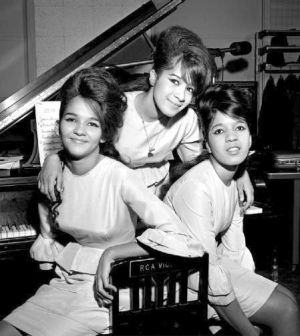
The Ronettes as young Bronx school girls, from left – Nedra Talley, Ronnie & Estelle Bennett, circa 1961-62.
Ronettes’ Origins
Ronnie Bennett and her sister Estelle, along with cousin Nedra Talley, began singing together as teenagers in Washington Heights, New York. They were all influenced at an early age by family members, many of whom were involved with or aspired to music and/or show business.
Ronnie, who would become the group’s lead singer, remembers getting the music bug at a very early age:
“My mom had seven brothers, and six sisters, and they all had, you know, show business… And they were playing Sam Cooke, and I’m like four years old [and saying], ‘I wanna do that’. So my uncles made me a spotlight from the Maxwell House coffee [can]. The first audience was my family: my girl cousins, boy cousins and my mom’s brothers and sisters. When I heard that applause, I got chills and I knew that was what I wanted to do…”
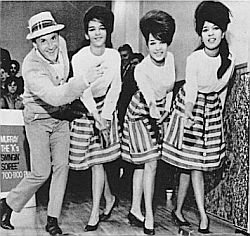
Early Ronettes shown here in a promotion with New York disc jockey, Murray the K, 1960s.

The Ronettes, early 1960s, from left: Ronnie Bennett, Nedra Talley, and Estelle Bennett.
They each had “big hair” as it was called — tall, black beehive hairdos — and they used a Cleopatra-style dark eye makeup. Their dresses and skirts were tight with slits up the sides, a near Oriental look.
They projected, in part, a “bad girl” look, fashioned from the girls they saw on the street, though they themselves were kept off the street. But at school sometimes, they were bullied for their mixed-race looks.
By 1961-62, they had cut a few unsuccessful records with the Colpix record label, then known as “Ronnie and the Relatives” before changing to “The Ronettes.” Around this time, a hot popular song titled, “He’s a Rebel,” by another girl group named The Crystals, was at the top of the charts. That song was produced by a 19 year-old recording studio whiz named Phil Spector who also owned a new record label named Philles.
Phil Spector
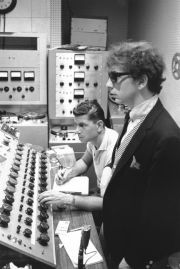
Phil Spector in L.A.’s Gold Star studio control room; Larry Levine at controls of 12-channel mixer, early 1960s. Ray Avery/Redferns.
“When he first heard my voice, I remember he came to one audition to see if I sounded as great as he thought I did, and he saw us at this little club… [W]hen he came to a rehearsal, and I sang one of Frankie Lymon’s songs, he knocked the bench over from the piano and said, ‘That’s the voice I’ve been looking for.’… I’ll never forget that. And that’s just before they went in and wrote ‘Be My Baby.'”
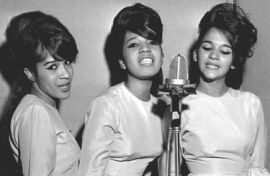
The Ronettes at work in the studio, early 1960s, from left: Ronnie, Estelle and Nedra.
At first, Phil Spector wanted to sign only Ronnie Bennett. Beatrice Bennett, however, insisted it was a package deal — all three or none at all. So in early 1963, the Ronettes became part of Phil Spector’s Philles Records, signing their contract in March that year.
When they started to work with Spector, the girls first served as background singers for others acts, including: Darlene Love with Bob B. Soxx & the Blue Jeans, Little Eva, Del Shannon, Bobby Rydell, Joey Dee, and others. But soon the Ronettes got some of Phil Spector’s undivided attention.
Wall of Sound
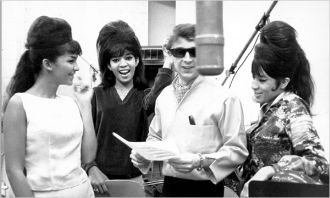
The Ronettes with Phil Spector in L.A. recording studio, 1963.
Spector was then in the process of crafting a distinctive sound which had already been used on some earlier recordings. This sound would become notable in all of his work — both in his “girl-group” songs and later work he did with artists such as the Righteous Brothers and Tina Turner.
The sound — sometimes described as the “Spector sound” — was unmistakable. It was big and full with lots of brass and drums; a sound that would seem to surge from the speakers. It became known as “the wall of sound;” a sound that had not been heard in popular recording to that point.

The Ronettes -- Estelle, Ronnie & Nedra -- with Phil Spector in L.A. recording studio, 1963.
Spector’s instrumentation filled all the space in a song without killing the vocals, while incorporating a good driving beat. The result of this orchestration and studio wizardry often had a clear demarcation in the song, producing an almost “wall-of-music”-like effect. Spector described his productions as “Wagnerian.” He also called them “little symphonies for the kids.”
New York Times writer Glenn Collins, years later, would acknowledge Spector’s successful technique, describing it as “overdubbing squadrons of guitars, pianos and percussion instruments in a wave of hormone-thrilling noise.” And indeed it was. Ask any aging baby boomer who grew up in that period.
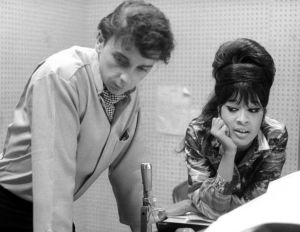
Phil Spector and Ronnie Bennett working on Ronettes music in L.A. recording studio, 1963.
Spector had a talented group of musicians working with him in the studio — though they were not necessarily well known by the public at the time. Among these musicians — all highly regarded, some known as “The Wrecking Crew” — were: Louis Blackburn, trombone; Hal Blaine, drums; Glen Campbell, guitar; Frank Capp, percussion; Al De Lory, keyboards; Steve Douglas, saxophone; Carol Kaye, bass, Jay Migliori, saxophone; Bill Pitman, guitar; Ray Pohlman, bass guitar; Don Randi, piano; Leon Russell, keyboards; and Tommy Tedesco, guitar.
Many of these musicians, and others, also worked with Spector on other hits songs. On some productions, Spector would also use any number of background singers, including Salvatore Bono and Cherilyn Sarkisian, before they became famous as the “Sonny & Cher” duo. Spector’s first work with the Ronettes resulted in a song titled, “Why Don’t They Let Us Fall in Love.” But this song was put on the shelf for a time while they tried to come up with something Spector felt was more marketable.
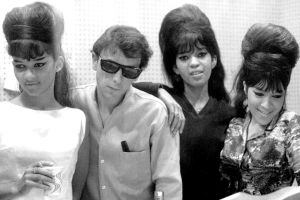
The Ronettes with Phil Spector in L.A. studio, 1963.
By July 1963 the studio work began on “Be My Baby.” Spector wanted to make the recording a showcase for Ronnie Bennett’s voice, but he also developed a stunning musical production using a variety of instruments. The song’s opening drum beat, for one — by Hal Blaine — is particularly prominent and key throughout, becoming a signature feature of “Be My Baby”. But there are also castanets and maracas mixed in, giving the song an exotic and calypso effect. Strings are included near the end, and in fact, “Be My Baby” was one of the first times Phil Spector used a full orchestra string treatment at the Gold Star studio. And of course, also notable on “Be My Baby” are Ronnie Bennett’s vocals, and her “woh-oh-ohs,” becoming trademark for this song, and in variation, for other songs that followed. One later listener of Phil Spector’s productions, and an awe-struck discoverer of Ronnie Bennet’s voice, was Michael Enright, who later became a Time magazine correspondent, offering this description of Ronnie Bennett’s voice:
“…Ronnie had a weird natural vibrato — almost a tremolo, really — that modulated her little-girl timbre into something that penetrated the Wall of Sound like a nail gun. It is an uncanny instrument. Sitting on a ragged couch in my railroad flat, I could hear her through all the arguments on the street, the car alarms, the sirens. She floated above the sound of New York while also being a part of it — …stomping her foot on the sidewalk and insisting on being heard.”
Spector Smitten
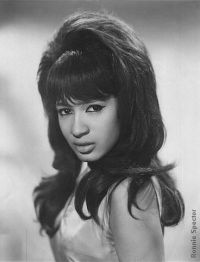
Ronnie Bennett, 1967 photo.
In the studio, however, Phil Spector was a hard-charging, no-nonsense producer, putting his singers and musicians through the wringer at times. One report has it that he made the musicians on “Be My Baby” do many dozens of takes before he was satisfied with the result. “According to legend,” says one account, “42 run-throughs took place over the course of four hours before Spector gave [studio engineer Larry] Levine the go-ahead to roll tape on ‘Be My Baby’…,” adding however, that this was “fairly conventional for a man who used the studio as an instrument in itself.” Ronnie Bennett and Spector had spent several weeks in New York rehearsing the song prior to Ronnie’s flying out to L.A.’s Gold Star studio. She was the solo Ronette in the “Be My Baby” vocals session.“Be My Baby” became a worldwide hit… It would sell more than two million copies in 1963 alone. It then took about three days to record her performance to Spector’s satisfaction. “We didn’t have to work hard to get Ronnie’s performance,” explained studio engineer Larry Levine to writer Richard Buskin in a 2007 Sound on Sound magazine article, “but we had to work hard to satisfy Phil. He’d spend an inordinate amount of time working on each section and playing it back before moving on to the next one, and that was very hard for the singers.” Levine would also add: “I always commiserated [with the singers] because Phil didn’t pay too much attention to them. He treated them as if they were another instrument. I mean, they weren’t ill-treated, they were just ignored.” However, the hard studio work on “Be My Baby” paid off. The July 1963 edition of Billboard music magazine reviewing the song called the Ronettes a top singing group “who handle this dramatic material with flair,” adding that the song’s backing “has a stunning, rolling rock sound that’s bound to make the disc score with the kids.” Indeed it did. “Be My Baby” became a worldwide hit, reaching No. 2 on the U.S. pop chart and No.4 on the R&B chart by mid-October 1963, and No. 4 on the U.K. charts the following month. It would sell over two million copies in 1963 alone. The Ronettes were on their way and were soon being sought out in hot demand to sing and make personal appearances.
Caravan of Stars
“…What people don’t know is that when Dick Clark wasn’t doing American Bandstand, he was on a little dinky bus along with all the other acts, whether it was Little Eva or Frankie Avalon or Bobby Rydell, and it was so much fun. I love Dick Clark — when we went on our first tour with Dick Clark’s Caravan of Stars, he only had a little bunk in the front to lay down in, and he would give me or the other two Ronettes the bunk, and he would let us lay down and he would stand next to the bus driver or with his wife. He didn’t demand anything just because he was the great Dick Clark. You could tell that he wanted everybody to make it. He was a man, and he was rich and he had his own TV show every Saturday — but to actually see this man on a bus, with all the groups, and not letting any of the groups go into hotels when they would give the black groups a hard time. I remember going inside diners and getting hamburgers for a lot of the black guys — I never thought about black or white until I traveled on the Dick Clark tours, and I saw people afraid to go into a restaurant because of the color of their skin and what might happen to them if they did.”

Phil Spector’s 1963 Christmas album, featuring songs that have become seasonal favorites. Click for CD or digital singles.
Christmas Album
In November 1963, the Ronettes recorded an album of Christmas music in New York with Phil Spector — A Christmas Gift for You. This album featured songs by the Ronettes, Darlene Love, the Crystals, and Bobby Sox & the Blue Jeans — each group shown on the album cover emerging from Christmas gift boxes. In one of those classic moments of bad timing, the album happened to be released at the time of the assassination of President John F. Kennedy, which dampened its reception given the grieving national mood. However, in subsequent years, and to this day, several of the Spector-produced and Ronettes-styled rock-n-roll Christmas songs from this album — including, “Sleigh Ride”, “I Saw Mommy Kissing Santa Claus,” and “Frosty the Snowman” — have become Christmas classics and popular seasonal favorites.
“Baby, I Love You”
By 1964, Phil Spector was now managing the Ronettes as well as producing their songs and selling their records. “Baby, I Love You” — the Ronettes’ second single and the follow-up to “Be My Baby” — had been recorded in late 1963.
Music Player
“Baby, I Love You”-1964
Written by Jeff Barry, Ellie Greenwich, and Phil Spector, “Baby, I Love You” featured Ronnie and a contingent of musicians, including, Leon Russell on piano with backing vocals from Darlene Love, Cher, and others.
Some music critics categorize this song as “industrial strength” wall-of-sound, though still masterful, with Ronnie’s voice floating above the thick instrumentation. Spector used extensive over-dubbing on this recording until he had the equivalent of 20-25 voices to compliment and balance out the dense instrumental tracks. “Baby, I Love You” first charted in late December 1963, peaking at No. 24 on the Billboard chart in January 1964 and No. 11 on the U.K. charts in February.
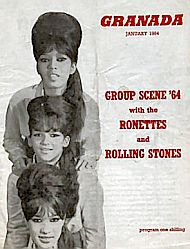
U.K. tour bill, Ronettes & Rolling Stones, January 1964.
U.K. Tour
By December 1963 and early 1964, with their two singles in the U.K. Top 20, the Ronettes had become quite popular in the U.K. and they began a tour there. On the tour, the Ronettes were the top of the bill, with the Rolling Stones providing their opening act. They were among the first girl groups to produce anything close to hysteria in British audiences.
The U.K. press ran headlines like, “Girls Scream at Stones, Boys for Ronettes.” While in the U.K., they also made a much-noticed appearance on the I-TV pop show, Ready, Steady, Go!
On the tour, the Ronettes traveled with Rolling Stones in a van as they went to various performances in the U.K. “I remember times when the fog was so thick, we’d have to pull over,” Ronnie would later report. “Keith [Richards] and I would walk up to some stranger’s house to ask for a cup of tea!” Ronnie, in later interviews, would further elaborate on some of their travels: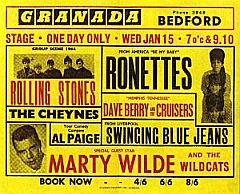
U.K. poster bill for Ronettes, Rolling Stones & others, January 1964.
“…We were headliners over in London, and … the Rolling Stones, they were our opening act… So that’s how we met them actually. And we all traveled together. They were great guys. And I loved Keith. He loved me. My sister was usually with Mick … and Nedra was with Brian, you know. But we all were together… Like, having dinner together and eating. There was not a lot of sex and all that kind of stuff going on with us. I think that came later on with the [Stones’] groupies and all that. But with us, there was none of that… unfortunately (laughs). My mother toured with us everywhere, so I didn’t get really a chance to do anything, but I didn’t want to then…”
Back in the States, as well, the Ronettes always traveled with at least one family member. According to one report, when they were playing a two-week date in Wildwood, New Jersey, they were asked to stay over an additional week. And when that suggestion became a more forcible proposition, one of the Ronettes’ aunts, along as chaperone, called back home to a contingent of several burly uncles to come to the rescue and get the girls home.
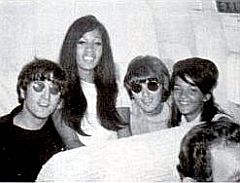
1960s photo of Ronettes & Beatles who appear to be, from left: John Lennon, Estelle Bennett, George Harrison & Nedra Talley.
More Hit Songs
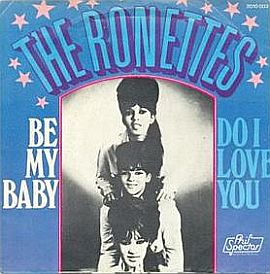
1964 Ronettes’ singles, “Be My Baby” and “Do I Love You” on the Phil Spector Int’l label, 7" Belgium issue.
Music Player
“Do I Love You”-1964
In the summer of 1964, “Do I Love You,” a joint composition by Spector and writers Vinnie Poncia and Pete Androli, was recorded by the Ronettes. The song’s production is especially noted for its powerful introduction. And despite reaching only No. 34 and No. 35, respectively in the U.S. and U.K., “Do I Love You” is regarded by many critics as one of Spector and the Ronettes’ best recordings. The song opens with finger snapping and hand clapping, with Ronnie singing her “oh-oh’s,” backed by a lush chorus and full instrumentation.
During 1964, Spector was also doing some test-marketing of Ronnie Bennett as a solo act — using the name “Veronica” and issuing two singles of her music on the “Phil Spector” record label. One of the songs was a cover of an earlier ballad, “I’m So Young,” and the other, a Jeff Barry / Ellie Greenwich / Phil Spector song titled, “Why Don’t They Let Us Fall in Love.” Each of these was also backed by the other two Ronettes.A sample DJ-only copy of the latter song appears at left. However, these songs were only on the market very briefly, pulled back almost immediately after release.
Spector, meanwhile, was also getting some attention in the media, as one article by writer Tom Wolfe in 1964 described him as “the first tycoon of teen.” Spector by this time was already a millionaire.
“…In The Rain”
In November 1964, Spector and the Ronettes released their fifth single, a dramatic ballad titled, “Walking in the Rain.” This song was written by Barry Mann, Cynthia Weil, and Phil Spector, with Ronnie’s vocals done in one studio take.
Music Player
“Walking in the Rain”-1964
The song opens with the sound of a recorded thunder storm and continues with the sound of rain throughout, an effect that was unique for its time.
“Walking in the Rain” rose to No. 23 on the Billboard pop charts and later won a Grammy for its innovative use of the ‘rain’ sound effects. Ronnie would also mark this song as a personal favorite. “It was my favorite,” she said in a 2009 interview, “because it was the first song that I sang in a slow [way] … so people could really hear my voice.” In another interview, she also stated “it was a more mature emotional recording than my previous records. I really felt I was developing as an artist after recording it, plus I did the vocal in just one take.”
In 1964, an album of the Ronettes songs, mostly incorporating their singles to date, was released under the title, Presenting the Fabulous Ronettes Featuring Veronica.This was still the era when the 45 rpm single was the dominant form of pop music marketing rather than the album. This Ronettes album, however, charted at No. 96 on the Billboard album chart, not an exceptional showing.
The album, in some ways, marked the end of what some have called the “golden period” for Spector and the Ronettes — running for about 16 months between September 1963 through December 1964 — when the Ronettes placed five singles in the Top 40.
By this time as well, the British invasion was coming into full force — in fact, through most of 1964 — as the Beatles and other U.K. artists began capturing the pop charts with a new sound.
Phil’s Other Artists
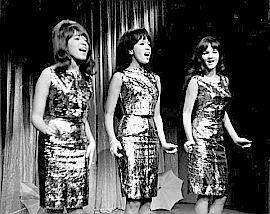
The young Ronettes -- minus the beehive hairdos -- performing sometime in the 1960s.
Ronnie Bennett and Phil Spector, meanwhile, were pretty much a couple by this time. Spector was also still the manager of the Ronettes. However, in 1966, he began to control the career of his wife-to-be by limiting her outings and performances. During the summer of 1966, on the Beatles’s last U.S. tour during the month of August, the Beatles had specifically requested the Ronettes as their opening act. But Spector would not allow Ronnie to go on the tour, and replaced her with one of her cousins.
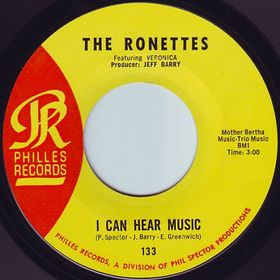
“I Can Hear Music,” by the Ronettes, September 1966, their last single on the Philles label, which was then shut down. Click for digital.
In 1966, Spector also recorded two Ronettes songs co-written by Harry Nilsson, “Paradise” and “Here I Sit,” but he held back the tapes for decades. And by September 1966, Spector had suffered a major disappointment with Tina Turner’s “River Deep-Mountain High” — a production he regarded as one of his best. However, at the time, it fared poorly on the U.S. music charts at No. 88, though rising to No. 3 in the U.K.
That’s about when the Philles label was formally shut down and the Ronettes would disband. Also in the mid-60s, Nedra Talley married New York radio station programming director Scott Ross, while Estelle Bennett married road manager Joe Dong.
Ronnie & Phil
During their marriage years, however, there would be two singles produced featuring Ronnie. In 1969, “You Came, You Saw, You Conquered” was released as a Ronettes song, “featuring the voice of Veronica.” In 1971, “Try Some, Buy Some,” another single by Ronnie Spector, was released on the Apple record label. Phil Spector by then had begun working with the Beatles in London in 1969, helping produce their Let It Be album. And it appears at least some of the Beatles played a role in helping Ronnie record “Try Some Buy Some.” In 1971, Beatle George Harrison wrote and co-produced this song with Phil Spector for Ronnie on the Apple label. The song also has the distinction of having all four Beatles playing on the track.
Back in the States, meanwhile, Phil Spector’s behavior toward Ronnie in their marriage grew increasingly erratic and controlling. Ronnie wanted to continue her singing, but Spector refused to book recording sessions for her. Beyond that, he wouldn’t allow her to leave the house without his permission. He became psychologically abusive, allegedly threatening to kill her, monitoring her phone calls, and forbidding her to read books or see friends. In the marriage, Phil Spector’s behavior toward Ronnie grew increasingly erratic and controlling. Spector reportedly carried a gun on occasion during this time as well. The couple separated in 1973 and divorced in 1974. However, Ronnie had developed a serious drinking problem that interfered with her attempts to relaunch her career. Still, through the 1970s — using Ronnie Spector as her recording name — she did some occasional solo recording, tried reforming a Ronettes group with two new singers for a time, and did some backup-singing for Bruce Springsteen. In 1977 she recorded a cover version of a Billy Joel song, “Say Goodbye To Hollywood.” In 1980, a solo album Siren was produced and she also cut some tracks with the E-Street Band, including “Say Goodbye to Hollywood” (see image, later below). In 1986 she had a No. 4 hit duet with Eddie Money, “Take Me Home Tonight,” in which she incorporated the chorus line from 1963’s “Be My Baby.” She and Money also had an MTV music video for the song, and they performed it on American Bandstand and at the American Music Awards. In 1987, another solo album, Unfinished Business, was issued. But neither it nor her earlier album, Siren, had charted.
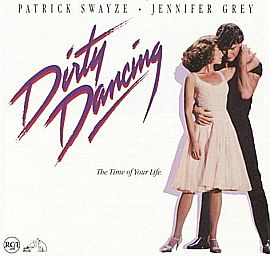
“Dirty Dancing’s” soundtrack album, with “Be My Baby,” spent 18 weeks at No. 1 on the Billboard charts; sold 42 million copies. Click for CD.
In fact, the Dirty Dancing album spent 18 weeks at No.1 on the Billboard album chart, sold 42 million copies worldwide, and became one of the best-selling albums of all time.
But none of the money from these sales came to the Ronettes. This and other developments — including use of Ronettes’ songs on numerous 1960s compilation albums, videocassettes, films, TV shows, and advertising — raised issues about the Ronettes’ song rights, licensing fees, and past royalties never paid. In 1987, the Ronettes filed a lawsuit against Phil Spector over these issues, but the case bogged down in red tape and legal maneuvering for nearly a decade before coming to trial. More on this case in a moment.
Ronnie’s Book
Alan Light for Rolling Stone described Ronnie Spector’s book as “an entertaining, often disturbing autobiography…” And the San Francisco Chronicle described it as “an unflinching look at a dream that turned into a nightmare.” A subsequent paperback edition followed, and more than a decade later, Onyx Books republished the book in a revised and updated version released in 2004.
Vanity Fair writer Dominick Dunne, who had occasion to read the book some years later in 2007 wrote: “…I couldn’t put the book down…. Ronnie was an absolute prisoner in her own mansion, surrounded by staff. She had nothing to do all day but drink, and drink she did. Phil had lost interest in her career. He told her not to talk to the servants…. Ronnie and Phil’s marriage was one of day-to-day madness, from which she ultimately escaped in bare feet. She ran down the hill to Sunset Boulevard and caught a taxi out of his life forever.” Ronnie, years after her flight from Phil, eventually remarried and had two sons with new husband, Jonathan Greenfield, living with their family in Connecticut. But the old battles with Phil Spector continued to wend their way through the courts.
Legal Battle
By 1998, the Ronettes’ now decade-old lawsuit against Phil Spector — legally titled, Greenfield v. Philles Records, Inc. — had made its way to trial in New York. The Ronettes’ had sued Spector for unpaid royalties since 1964, and for unpaid income made from his licensing of Ronettes’ music in movies, television, advertising, compilation albums, reissues, and other uses. The Ronettes were seeking $10 million in damages for breach of contract as well as former and future earnings from their original recordings.

Cover of 1991 “Phil Spector: Back to Mono” CD boxed set of four discs from ABKCO, which included seven of the Ronettes’ songs. Click for box set.
As the trial proceeded in June of 1998, each side presented its arguments. “Phil Spector was a boy genius in music, producing, assembling, marketing girl groups,” said the Ronettes’ attorney, Alexander Peltz, “but he was also a genius in greed, vengeance and spite.” “He’s totally cheated us for 35 years.”
– Nedra Talley Ross, 1998 Peltz said the Ronettes’ efforts to recoup earnings from Spector had been fruitless. Spector, for his part, said the Ronettes owed him money for production costs. Taking the stand at the trial, Spector said that the cost of recording the 28 songs made by the Ronettes far exceeded his income, and the group actually owed him money. “Philles Records is still owed a considerable amount of money by the Ronettes,” he contended. The Ronettes, of course, saw this quite differently. ”He’s totally cheated us for 35 years,” said former Ronette, Nedra Talley Ross at the time of the trial, then 52 years old and owner of restaurant and an importing business in Virginia.
In court, Spector’s attorney, Andrew Bart, also stated that Ronnie Spector had signed away her portion of the group’s earnings in her 1974 divorce settlement. Ronnie Spector had indeed signed the 1974 divorce settlement that included a clause forfeiting all future record profits. However, in her court appearance she said the settlement with Spector was made under duress. Phil Spector, she explained, held her as a virtual prisoner when they lived together at his estate. Ronnie stated in court that she feared for her life, explaining that Phil had threatened her with guns and hit men. He would confiscate her shoes to keep her from leaving the estate. In fact, she had fled Spector’s estate barefoot around the time of her divorce “so as not to arouse Phil’s suspicions.” She also stated in court that she was “fearful for my life,” explaining that Phil Spector had threatened her with guns and hit men. He once threatened to have her killed unless she gave up custody of their children. “‘I’m going to kill you,'” Ronnie said, quoting her ex-husband on a telephone call he made to her. “‘I’m going to have a hit man kill you if you don’t drop all these charges.'” When the two were married, they had adopted three boys — an infant son and two six-year-old twins. But in the divorce, Ronnie gave up the children. Phil Spector, for his part, denied that he kept his wife as an involuntary prisoner and he rejected the hit man allegations, saying ”I’ve heard them over the last 20 years.” And as for back royalties due the Ronettes, Spector said he would concede to owing, at most, $350,000 in unpaid royalties.
In June 2000, the court’s ruling came down from Justice Paula Omansky of State Supreme Court in Manhattan. Omansky, while noting that Spector’s contributions to the Ronettes’ success could not be underestimated, for he was the composer of their songs and creator of the sound that made their recordings famous. The Ronettes’ lawsuit also sought ownership of the 28 master recordings of the songs they made with Spector in the 1960s. Still, she found that Spector had underpaid the Ronettes based on his 1963 contract with them. She also found that Spector, as the rights holder of all Ronettes recordings, had made millions of dollars from them in ways not authorized by the 1963 contract. She said the contract covered only royalties on sales of phonograph records, but that Spector had sold the recordings for use as background music in movies and advertising, and had licensed without authority the group’s master recordings to third parties — for “oldies” compilations, video- cassette recordings, and the like. The Ronettes’ lawsuit also sought ownership of the master recordings of the 28 songs they made with Spector from 1963 to 1967. But Judge Omansky denied this request, writing in her decision that “rescinding the 1963 recording contract and taking ownership of the masters away from Spector is not warranted.” She did rule that the Ronettes were entitled to $2.6 million in royalties plus interest.
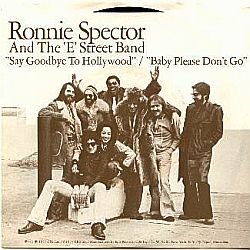
Although Ronnie Spector recorded songs in her solo career, she noted during the 1998 royalties trial that Phil Spector’s restrictions on her performing Ronettes’ songs hurt her career. Click for album.
The case by this time had attracted outside interest — with the Recording Industry Association of America, a trade group, joining Spector’s side and urging the court to uphold his ownership claim in the 1963 contract as absolute. Joining the Ronettes in a friend of the court brief was the Recording Artists Coalition, a nonprofit group formed to help artists gain their legal rights. In November 2001, Spector’s appeal was denied, as the court upheld the lower court’s verdict and the $2.6 million award. Spector then appealed that ruling as well, taking the case to the New York State Supreme Court. This time, Phil Spector won.
In October 2002, a five-judge panel of the state Court of Appeals said it found the Ronettes’ plight sympathetic — i.e., earning less than $15,000 from their 1960s’ songs that topped the charts and made them famous. Still, these judges found the 1963 contract with Spector to be the governing authority giving him unconditional rights to the recordings, including future uses of those rights for whatever purpose. In the end, Phil Spector won. The 1963 contract he made with three young teenage girls prevailed, giving him full control over all rights and future uses of the Ronettes’ songs. “[T]he unconditional transfer of ownership rights to a work of art includes the right to use the work in any manner…,” said the ruling, “unless those rights are specifically limited by the terms of the contract.” This is what the Ronettes had given Phil Spector and Philles Inc. when they were teenagers back in 1963. It didn’t matter, for example, that the subsequent and various uses of music in film, advertising, video, etc. weren’t common in the 1960s, or even known about or invented in some cases. Since nothing was said in the contract about such “future rights and uses,” and lacking some stipulation that the Ronettes should receive a specified share of those rights, the Ronettes received, and will continue to receive, nothing from those uses. Phil Spector got those as well. On top of this, the judges in this final appeal also reversed the lower court’s ruling that the Ronettes were entitled to the music industry’s standard 50 percent royalty rate on sales of records, tapes, and compact discs. Again, the court reverted to the 1963 contract and the specified royalty rate of an average of 3 to 4 percent. Thus, the $3 million award first given the Ronettes from the lower court was substantially reduced. After lawyers’ fees, each of the Ronettes took home something around $100,000, and perhaps a bit more.
Hall of Fame
Another outgrowth of the split between Phil and Ronnie Spector, in addition to the battle over royalties and song rights, was Phil Spector’s alleged blocking of the Ronettes from entering the Rock and Roll Hall of Fame. First established in the mid-1980s, the Rock and Roll Hall of Fame inducts a small number of artists and other influential music industry players into the Hall each year. The first group was inducted in January 1986 and included Little Richard, Elvis Presley, Fats Domino, Ray Charles, Chuck Berry, Sam Cooke, The Everly Brothers, Buddy Holly, and Jerry Lee Lewis.

The Ronettes performing in the mid-1960s, from left: Estelle, Ronnie, and Nedra.
Groups or individuals are qualified for Hall of Fame induction 25 years after the release of their first record. Phil Spector, for his music production talents, was inducted in 1989, and he also became a member of the Board of Governors. However, Spector was reported to have deliberately prevented The Ronettes and Darlene Love from being nominated for induction into the Rock and Roll Hall of Fame. Both Love and the Ronettes had been eligible for nomination for a considerable period. And both Love and the Ronettes had sued Spector for back pay and royalties.
In any case, Phil Spector soon had much bigger problems. In 2003 he was arrested for the shooting death of actress Lana Clarkson at his California estate, leading to a second degree murder charge. After a 2007 mistrial, he was convicted in 2009, and was given a prison sentence of 19 years to life, which he continued serving until his death in January 2021 at age 81.
The Ronettes, meanwhile, were inducted into the Rock and Roll Hall of Fame on March 12, 2007 at the 22nd annual induction dinner. Keith Richards of the Rolling Stones was their presenter. Among those present at the ceremony, including all of the Ronettes, was Nedra Talley Ross’ mother, Susan, who was one of those family members who had worked hard for the Ronettes in their early days, banging on doors to help get the group noticed.
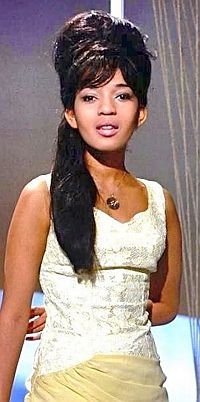
Estelle Bennett, 1960s.
Estelle’s Pain
In February 2009, Estelle Bennett was found dead in her apartment. She reportedly died from colon cancer. She was 67 years old. Bennett was found by Kevin Dilworth, a friend and former Newark, New Jersey Star-Ledger newspaper reporter. “I think she really just died of a broken heart,” said Dilworth in one interview following her death. “After [the Ronettes] disbanded in 1966, I don’t think she was ever right again…” Dillworth added that the only time he really saw her come to life was at the Rock and Roll Hall of Fame of March 2007: “When they came out of the main ceremony… when she walked down the hallway, and the paparazzi … all the flashing cameras, and the people asking for autographs … her eyes just lit up. She was so excited, and she was back on top of the world again. But she went right back to anonymity.” Former Ronette and cousin Nedra Talley Ross, reported that Estelle had led a hard life, struggling with schizophrenia and anorexia.
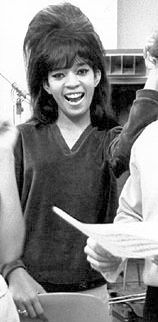
Estelle Bennett in happier times, 1963 L.A. studio.
But when the success of the Ronettes came to an end, Estelle took it hard. Her cousin, Nedra said that “Estelle did not want the Ronettes to end.” After the group broke up in 1966, and after Ronnie married Phil Spector 1968, Estelle seemed to lose her moorings. In the mid-1960s, Estelle had married as well, to road manager Joe Dong. And she tried a bit of a solo career for a time, but it never took off. Thereafter she left music and her life began sliding into another world. At one point, Estelle Bennett was hospitalized with anorexia. Not long thereafter her grip on reality began to loosen. In recent years, according to her 37 year-old daughter, Toyin Hunter, Estelle sometimes wandered the streets of New York, telling people she would be performing with the Ronettes at a particular nightclub. Hunter explained she had never really known who her mother was. “From the time I was born she suffered with mental illness,” Hunter said, “I never really got to know Estelle in a good mental state.”

The young Ronettes in the 1960s – from left, Ronnie, Estelle & Nedra.
“They cleaned her up and made her look as well as possible…She looked the best she could for somebody who lived on the street. It broke my heart.”
But all agreed that in her prime and growing up, Estelle had been a force in creating the Ronettes’ style and act — and that she had a heart of gold. “Not a bad bone in her body,” said Ronnie in a press statement. “Just kindness.”
“Estelle had such an extraordinary life,” said her cousin, Nedra. “To have the fame, and all that she had at an early age, and for it all to come to an end abruptly. Not everybody can let that go and then go on with life.”
The Ronettes’ Legacy
The Ronettes’ music lives on to this day as part of the special sound that came out of the early 1960s’ music scene. It was a productive time for new music of all kinds then, and the Spector-Ronettes sound still resonates today, being discovered by new generations of listeners and revered as well by any number of musicians and producers who acknowledge its influence. “I was a big Phil Spector fan when I was in high school,” said singer Bob Seger in a 2007 interview. “I was a junior in high school in 1962, so it was ‘Be My Baby’ by the Ronettes,” he said. “All those Spector [songs] with the big drums and the big productions. I love the way Ronnie sang too.” Billy Joel and Bruce Springsteen have both cited the Ronettes and Ronnie Bennett as an influence.Over the years, the accolades for “Be My Baby” alone have been considerable. In 2004, the song was ranked No. 22 by Rolling Stone in its list of “The 500 Greatest Songs of All Time.” Also called a “Rosetta stone” for those aspiring to studio work, “Be My Baby” has been noted as one of the best songs of the 1960s by NME, Time, and Pitchfork magazines. Billboard named it the No. 1 song on their list of the “100 Greatest Girl Group Songs of All Time.” In 1999, it was inducted in the Grammy Hall of Fame, and in 2006, the U.S. Library of Congress added the Ronettes’ “Be My Baby” to the National Recording Registry, a special recognition for works regarded as culturally or historically important. In terms of radio play and media use, “Be My Baby” in 2013, after more than 50 years, was still holding its own. BMI officials estimated at that time the song had been played in 3.9 million feature presentations on radio and television since 1963.
Ronettes’ songs have also been covered by numerous groups. “Be My Baby” alone has been covered by at least a dozen or more artists, including Andy Kim, who had a 1970 chart hit with it. The song has also been covered by: John Lennon, The Lightning Seeds, the Bay City Rollers, Blue Öyster Cult, We Are Scientists, Psyched Up Janis, Maroon 5, Glasvegas, Ivy, Linda Ronstadt, Whigfield, Ultima Thule, Jason Donovan, Travis and Remi Nicole. The song’s opening drum beat has also been appropriated by a number of artists.
“Baby, I Love You” has been covered by Cher, The Ramones, Linda Ronstadt, Nicky Onidis and Bad Boys Blue, among others. In 1969, an Andy Kim cover of this song became a Top Ten Billboard hit and earned gold record status. In 1973 in the U.K., Dave Edmunds released a version that rose to No. 8 on the U.K. singles chart. And Phil Spector produced a 1980 Ramones’ version which also rose to No. 8 on the U.K. charts. “Baby I Love You” is also on the soundtrack of the 1995 Hugh Grant-Julianne Moore film Nine Months.
Of the three Ronettes, only Ronnie continued to perform after the group broke up in the 1960s. And there is more detail on Ronnie’s career at her website and elsewhere on the web, as well as her biography, mentioned below, available at Amazon.com.
Other stories at this website include the video clip and commentary at, “Levis “Be My Baby’ TV Ad” and also “1960s Girl Groups,” covering the prominent groups in that genre during the 1958-1966 period with more than a dozen songs. See also the “Annals of Music” page for additional story choices.
Thanks for visiting – and if you like what you find here, please make a donation to help support the research and writing at this website. Thank you. – Jack Doyle
|
Please Support Thank You |
_________________________________
Date Posted: 18 January 2010
Last Update: 6 April 2024
Comments to: jackdoyle47@gmail.com
Article Citation:
Jack Doyle, “Be My Baby, 1960s-2010,”
PopHistoryDig.com, January 18, 2010.
_________________________________
Books at Amazon.com…
Sources, Links & Additional Information
 Ronettes’ Estelle Bennett & Paul McCartney, 1960s. |
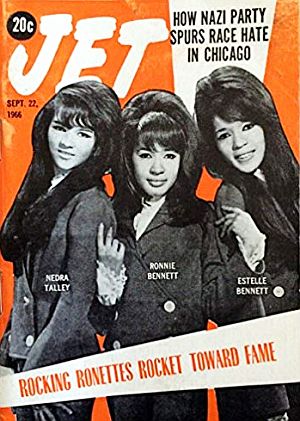 September 22, 1966: Ronettes on cover of Jet magazine in feature story, "Rocking Ronettes Rocket Toward Fame". |
“The Ronettes/Ronnie Spector,” in Holly George-Warren and Patricia Romanowski (eds), The Rolling Stone Encyclopedia of Rock & Roll, Rolling Stone Press, New York, 3rd Edition, 2001, pp. 836-837.
“The Ronettes,” Rock & Roll Hall of Fame & Museum, Induction Year: 2007.
SteveHuey, “The Ronettes, Biography,” All Music.com, 2009.
Nick Cohn, “Phil Spector,” in Anthony De Curtis and James Henke (eds), The Rolling Stone Illustrated History of Rock & Roll, Random House, New York, 1992, pp.177-188.
Bernard Weinraub, “Hey Man! It’s Murray the K and the Big Beat,” New York Times, Sunday, June 27, 1965, p. X-17.
“A Giant Stands 5 Ft. 7 In.,” Time, February 19, 1965.
Kurt Loder, “Ronnie Spector’s Rock Odyssey,” Rolling Stone, October 16, 1980, p. 26.
“The Ronettes,” HistoryofRock.com.
“The Ronettes,” Wikipedia.org.
“The Ronettes,” ClayColeShow.com, April 28, 2009.
Ronnie Spector and Vince Waldron, Be My Baby: How I Survived Mascara, Miniskirts and Madness, or My Life As a Fabulous Ronette, New York: Harmony Books, 1990.
Chuck Miller, “Ronnie Spector: For Every Kiss You Give Me, I’ll Give You Three,” Goldmine December 17, 1999, p.15-20.
Michael Enright, “The Obsessionist,” Time, Friday, October 13, 2000.
Glenn Collins, “A 90’s Refrain For a 60’s Girl Group; Ronettes’ Suit Says Phil Spector Owes Them $10 Million,” New York Times, June 26, 1998.
Sharon Krum, The Guardian, “Courting Royalties: Sixties Girl Group the Ronettes Sue to Win Back Song Rights,” Pittsburgh Post-Gazette, Tuesday, August 11, 1998, p. E-7.
“Ronettes Entitled to Back Pay From Phil Spector, Judge Rules,” Los Angeles Times, June 17, 2000, p. A-14.
Lew Serviss, “Decades Later, Ronettes May Get Gold for Oldies,”New York Times, June 18, 2000.
Robert F. Worth, “A Sad Song for the Ronettes: Court Reverses Royalty Rights,” New York Times, October 18, 2002, p. B-3.
“Ronettes Denied Song Royalties,” Los Angeles Times, October 19, 2002, p. E-2.
John Caher, “Ronettes’ Profits Limited by 1963 Contract,” New York Law Journal, October 21,2002.
Stephen Young, Holland & Knight, “Dispute Over Famous Rock ‘N Roll Rights Reminds Copyright Owners to Reserve Their Rights or Lose Them,” FreeLibrary.com, 2003.
“Phil Spector, Biography,” RollingStone .com, from The Rolling Stone Encyclopedia of Rock & Roll, New York: Simon & Schuster, 2001.
Larry London, “Bob Seger Returns After 11-year Absence,” VOA Standard/51 VOA.com, Washington, April 2, 2007.
“Ronnie Spector,” Wikipedia.org.
Dominick Dunne, “The Verdict Is Missing,” Vanity Fair, December 2007.
Ben Sisario, “Estelle Bennett, a Singer for the Ronettes, Is Dead at 67,” New York Times, February 13, 2009.
Ben Sisario, “A Life of Troubles Followed a Singer’s Burst of Fame,” New York Times, February 16, 2009.
Matt Dowling, “Ronettes Singer Estelle Bennett Dies at Age 67,” The Star-Ledger, February 12, 2009.
Richard Williams, “Estelle Bennett, Singer With the Influential 1960s Girl Group The Ronettes,” The Guardian (London), Monday, February 16, 2009.
Peter Lindblad, “Ronnie Spector: The Bad Girl Tells Her Story,” GoldMineMag.com, December 18, 2009.
Shannon Woodland & Andrew Knox, “Nedra Ross: ‘The Right Ronette’,” The 700 Club, CBN.com, March 15, 2007.
Richard Buskin, “Classic Tracks: The Ronettes ‘Be My Baby’,” SoundOnSound .com, April 2007.
Jay Warner, American Singing Groups: A History From 1940s to Today, Hal Leonard Corp., 2006. Click for copy.
Harriet Ryan, “Spector’s Long Legal Battles May Be Sapping His Fortune,” Los Angeles Times, April 8, 2009.
“The Ronettes,” NME.com.
Mark Ribowsky, He’s a Rebel: The Truth About Phil Spector – Rock and Roll’s Legendary Madman, New York: E. P. Dutton, 1989.
Mark Ribowsky, He’s a Rebel: Phil Spector, Rock and Roll’s Legendary Producer, New York: Perseus, 2007.
Mick Brown, “Phil Spector: From Jukebox to Jury,” The Independent, Monday, March 26, 2007.
Hal Blaine and David Goggin, Hal Blaine and The Wrecking Crew: The Story of the World’s Most Recorded Musician, Emery-ville, CA: Mix Books, 1990. Click for copy.
“Phil Spector,” Wikipedia.org.
“Phil Spector Found Guilty of Second-Degree Murder; A Look Back at the Music Legend’s Career, in Pictures,” Macleans. Ca, Monday, April 13, 2009.
Nancy Dunham, “Her Star Still Shines Bright,” Washington Post, (review of Ronnie Spector CD, Last of the Rock Stars), Friday, December 11, 2009.
Jason Ankeny, “Be My Baby,” Song Review, AllMusic.com.
Melinda Newman, “Ronettes Win A Round In Legal Bout,” Billboard, April 8, 1995, p. 16.
“Phil Spector / The Teddy Bears,” in Holly George-Warren and Patricia Romanowski (eds), The Rolling Stone Encyclopedia of Rock & Roll, Rolling Stone Press, New York, 3rd Edition, 2001, pp. 922-923.
